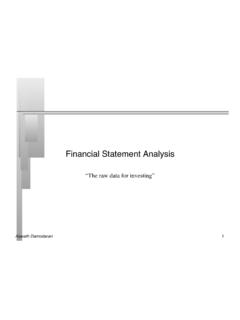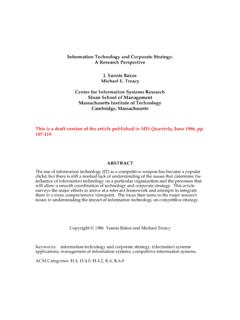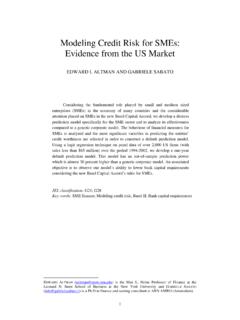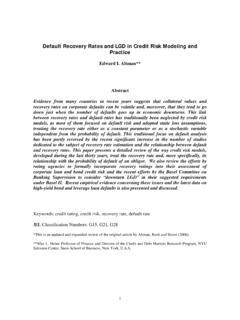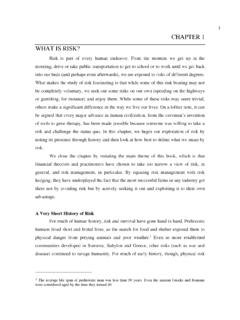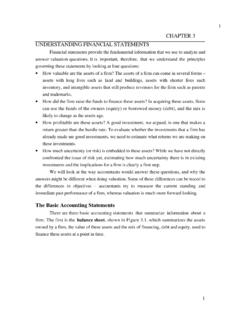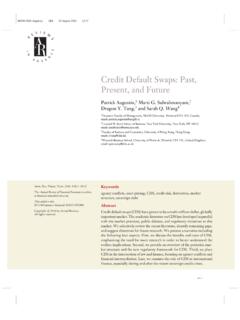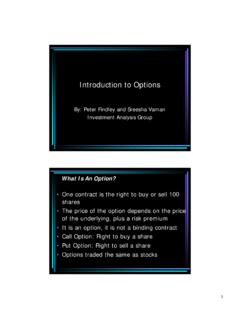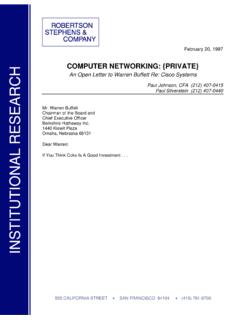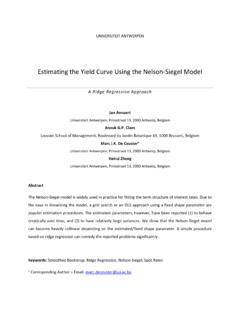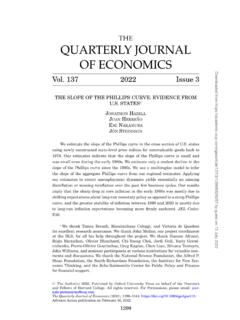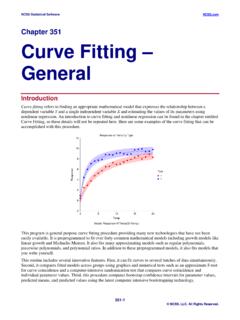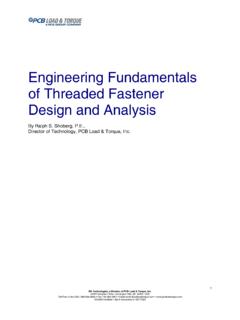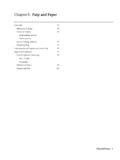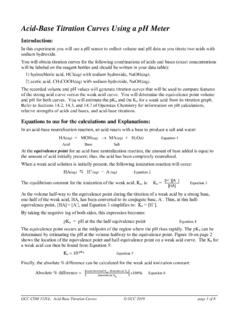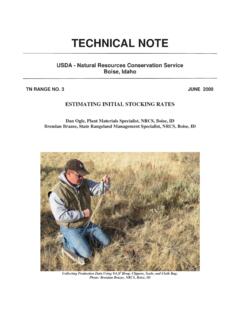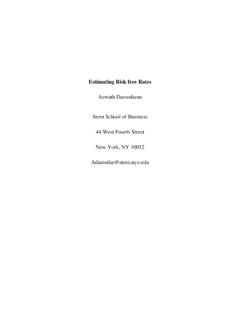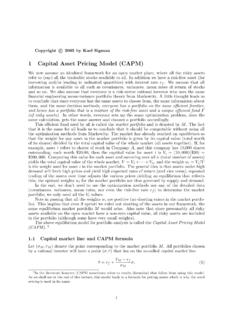Transcription of CHAPTER 4 HOW DO WE MEASURE RISK?
1 1 CHAPTER 4 HOW DO WE MEASURE RISK? If you accept the argument that risk matters and that it affects how managers and investors make decisions, it follows logically that measuring risk is a critical first step towards managing it. In this CHAPTER , we look at how risk measures have evolved over time, from a fatalistic acceptance of bad outcomes to probabilistic measures that allow us to begin getting a handle on risk, and the logical extension of these measures into insurance. We then consider how the advent and growth of markets for financial assets has influenced the development of risk measures. Finally, we build on modern portfolio theory to derive unique measures of risk and explain why they might be not in accordance with probabilistic risk measures. Fate and Divine Providence Risk and uncertainty have been part and parcel of human activity since its beginnings, but they have not always been labeled as such.
2 For much of recorded time, events with negative consequences were attributed to divine providence or to the supernatural. The responses to risk under these circumstances were prayer, sacrifice (often of innocents) and an acceptance of whatever fate meted out. If the Gods intervened on our behalf, we got positive outcomes and if they did not, we suffered; sacrifice, on the other hand, appeased the spirits that caused bad outcomes. No MEASURE of risk was therefore considered necessary because everything that happened was pre-destined and driven by forces outside our control. This is not to suggest that the ancient civilizations, be they Greek, Roman or Chinese, were completely unaware of probabilities and the quantification of risk. Games of chance were common in those times and the players of those games must have recognized that there was an order to the As Peter Bernstein notes in his splendid book on the history of risk, it is a mystery why the Greeks, with their considerable skills at geometry and numbers, never seriously attempted to MEASURE the 2 likelihood of uncertain events, be they storms or droughts, occurring, turning instead to priests and fortune Notwithstanding the advances over the last few centuries and our shift to more modern, sophisticated ways of analyzing uncertainty, the belief that powerful forces beyond our reach shape our destinies is never far below the surface.
3 The same traders who use sophisticated computer models to MEASURE risk consult their astrological charts and rediscover religion when confronted with the possibility of large losses. estimating Probabilities: The First Step to Quantifying Risk Given the focus on fate and divine providence that characterized the way we thought about risk until the Middle Ages, it is ironic then that it was an Italian monk, who initiated the discussion of risk measures by posing a puzzle in 1494 that befuddled people for almost two centuries. The solution to his puzzle and subsequent developments laid the foundations for modern risk measures. Luca Pacioli, a monk in the Franciscan order, was a man of many talents. He is credited with inventing double entry bookkeeping and teaching Leonardo DaVinci mathematics. He also wrote a book on mathematics, Summa de Arithmetica, that summarized all the knowledge in mathematics at that point in time.
4 In the book, he also presented a puzzle that challenged mathematicians of the time. Assume, he said, that two gamblers are playing a best of five dice game and are interrupted after three games, with one gambler leading two to one. What is the fairest way to split the pot between the two gamblers, assuming that the game cannot be resumed but taking into account the state of the game when it was interrupted? With the hindsight of several centuries, the answer may seem simple but we have to remember that the notion of making predictions or estimating probabilities had not developed yet. The first steps towards solving the Pacioli Puzzle came in the early part of 1 Chances Adventures in Probability, 2006, Kaplan, M. and E. Kaplan, Viking Books, New York. The authors note that dice litter ancient Roman campsites and that the citizens of the day played a variant of craps using either dice or knucklebones of sheep.
5 2 Much of the history recounted in this CHAPTER is stated much more lucidly and in greater detail by Peter Bernstein in his books Against the Gods: The Remarkable Story of Risk (1996) and Capital Ideas: The Improbable Origins of Modern Wall Street (1992). The former explains the evolution of our thinking on risk through the ages whereas the latter examines the development of modern portfolio theory. 3 the sixteenth century when an Italian doctor and gambler, Girolamo Cardano, estimated the likelihood of different outcomes of rolling a dice. His observations were contained in a book titled Books on the Game of Chance , where he estimated not only the likelihood of rolling a specific number on a dice (1/6), but also the likelihood of obtaining values on two consecutive rolls; he, for instance, estimated the probability of rolling two ones in a row to be 1/36. Galileo, taking a break from discovering the galaxies, came to the same conclusions for his patron, the Grand Duke of Tuscany, but did not go much further than explaining the roll of the dice.
6 It was not until 1654 that the Pacioli puzzle was fully solved when Blaise Pascal and Pierre de Fermat exchanged a series of five letters on the puzzle. In these letters, Pascal and Fermat considered all the possible outcomes to the Pacioli puzzle and noted that with a fair dice, the gambler who was ahead two games to one in a best-of-five dice game would prevail three times out of four, if the game were completed, and was thus entitled to three quarters of the pot. In the process, they established the foundations of probabilities and their usefulness not just in explaining the past but also in predicting the future. It was in response to this challenge that Pascal developed his triangle of numbers for equal odds games, shown in figure :3 3 It should be noted that Chinese mathematicians constructed the same triangle five hundred years before Pascal and are seldom credited for the discovery.
7 4 Figure : Pascal s Triangle Pascal s triangle can be used to compute the likelihood of any event with even odds occurring. Consider, for instance, the odds that a couple expecting their first child will have a boy; the answer, with even odds, is one-half and is in the second line of Pascal s triangle. If they have two children, what are the odds of them having two boys, or a boy and a girl or two girls? The answer is in the second line, with the odds being on the first and the third combinations and on the second. In general, Pascal s triangle provides the number of possible combination if an even-odds event is repeated a fixed number of times; if repeated N times, adding the numbers in the N+1 row and dividing each number by this total should yield the probabilities. Thus, the couple that has six children can compute the probabilities of the various outcomes by going to the seventh row and adding up the numbers (which yields 64) and dividing each number by the total.
8 There is only a 1/64 chance that this couple will have six boys (or six girls), a 6/64 chance of having five boys and a girl (or five girls and a boy) and so on. Sampling, The Normal Distributions and Updating Pascal and Fermat fired the opening volley in the discussion of probabilities with their solution to the Pacioli Puzzle, but the muscle power for using probabilities was 5 provided by Jacob Bernoulli, with his discovery of the law of large numbers. Bernoulli proved that a random sampling of items from a population has the same characteristics, on average, as the He used coin flips to illustrate his point by noting that the proportion of heads (and tails) approached 50% as the number of coin tosses increased. In the process, he laid the foundation for generalizing population properties from samples, a practice that now permeates both the social and economic sciences. The introduction of the normal distribution by Abraham de Moivre, an English mathematician of French extraction, in 1738 as an approximation for binomial distributions as sample sizes became larger, provided researchers with a critical tool for linking sample statistics with probability statements.
9 5 Figure provides a picture of the normal distribution. Figure : Normal Distribution 4 Since Bernoulli s exposition of the law of large numbers, two variants of it have developed in the statistical literature. The weak law of large numbers states that average of a sequence of uncorrelated random numbers drawn from a distribution with the same mean and standard deviation will converge on the population average. The strong law of large numbers extends this formulation to a set of random variables that are independent and identically distributed ( ) 6 The bell curve, that characterizes the normal distribution, was refined by other mathematicians, including Laplace and Gauss, and the distribution is still referred to as the Gaussian distribution. One of the advantages of the normal distribution is that it can be described with just two parameters the mean and the standard deviation and allows us to make probabilistic statements about sampling averages.
10 In the normal distribution, approximately 68% of the distribution in within one standard deviation of the mean, 95% is within two standard deviations and 98% within three standard deviations. In fact, the distribution of a sum of independent variables approaches a normal distribution, which is the basis for the central limit theorem and allows us to use the normal distribution as an approximation for other distributions (such as the binomial). In 1763, Reverend Thomas Bayes published a simple way of updating existing beliefs in the light of new evidence. In Bayesian statistics, the existing beliefs are called prior probabilities and the revised values after considering the new evidence are called posterior or conditional Bayes provided a powerful tool for researchers who wanted to use probabilities to assess the likelihood of negative outcomes, and to update these probabilities as events unfolded.

